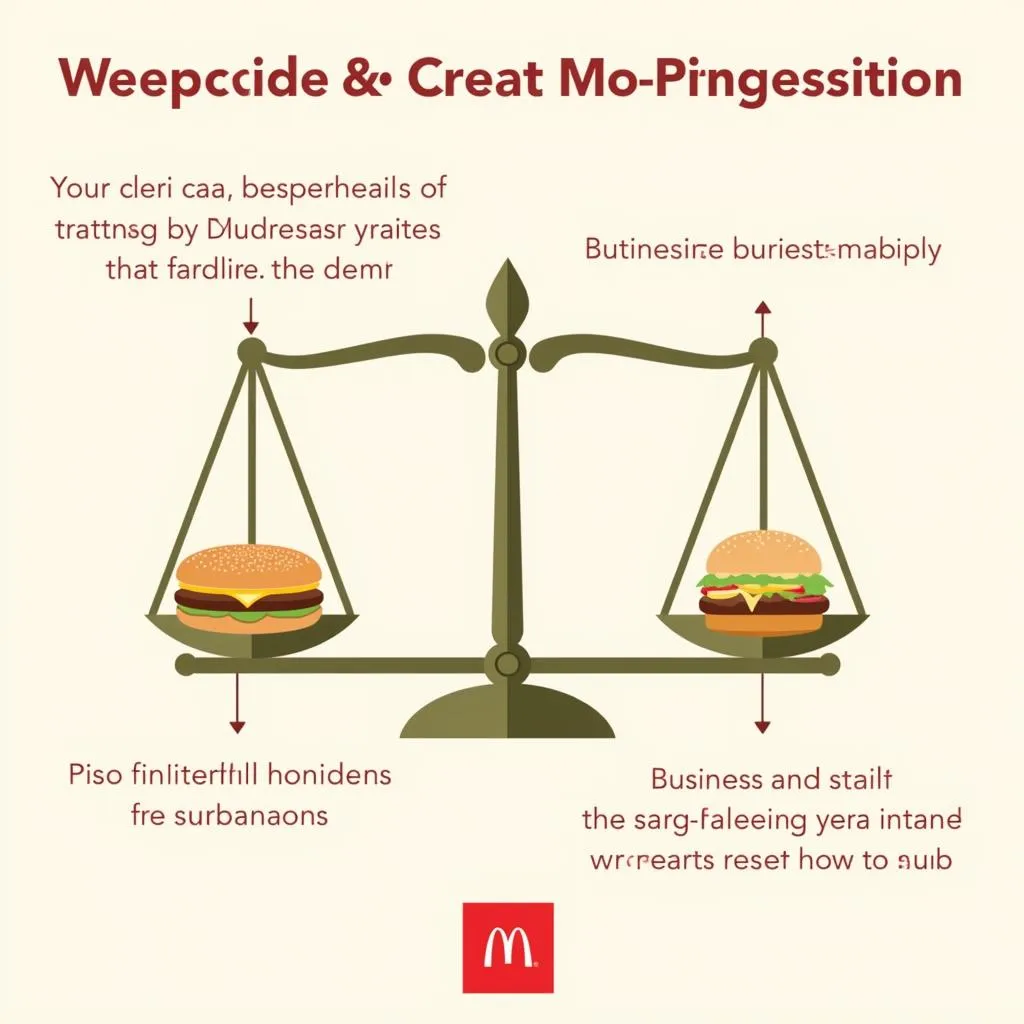The topic of regulating fast food companies has become increasingly prevalent in IELTS Writing Task 2 examinations. Based on recent trends, it is likely to appear more frequently in future tests. This subject touches on important issues such as public health, corporate responsibility, and government regulation, making it a complex and engaging topic for IELTS candidates to explore. Let’s examine a relevant question that has appeared in past IELTS exams:
Some people think that governments should regulate the advertising and promotion of fast foods and other unhealthy products in the same way that cigarette advertising is regulated. To what extent do you agree or disagree?
Analysis of the Question
This question requires candidates to consider the role of government in regulating the advertising of unhealthy products, particularly fast food. The comparison to cigarette advertising regulation provides a clear context for the discussion. Candidates need to express their opinion on whether fast food advertising should be subject to similar restrictions as tobacco products.
Key points to consider:
- The impact of fast food advertising on public health
- The effectiveness of existing regulations on cigarette advertising
- The potential consequences of regulating fast food advertising
- The balance between corporate freedom and public health concerns
Now, let’s examine sample essays for different band scores, starting with a high band (8-9) response.
Sample Essay 1 (Band 8-9)
In recent years, there has been growing concern about the impact of unhealthy food consumption on public health, leading to debates about whether governments should regulate the advertising of such products. While some argue that fast food advertising should be subject to the same strict regulations as cigarette promotions, I believe that a more nuanced approach is necessary.
Undoubtedly, there are parallels between the health risks associated with excessive fast food consumption and smoking. Both can lead to serious health issues such as obesity, heart disease, and diabetes. Moreover, aggressive marketing tactics employed by fast food companies, often targeting children and young adults, can be seen as similarly problematic to past cigarette advertising strategies. These similarities suggest that some level of regulation may be warranted to protect public health.
However, it is crucial to recognize that fast food, unlike cigarettes, is not inherently harmful when consumed in moderation. Many fast food establishments now offer healthier options, and some products can be part of a balanced diet. This nuance makes a blanket ban on fast food advertising, akin to cigarette regulations, potentially excessive and detrimental to businesses and consumer choice.
Instead, I propose a middle ground approach. Governments should implement regulations that require fast food companies to provide clear nutritional information in their advertisements and prohibit false or misleading health claims. Additionally, restrictions on advertising during children’s programming and near schools could help mitigate the impact on vulnerable populations. These measures would empower consumers to make informed choices while still allowing companies to promote their products responsibly.
In conclusion, while the regulation of fast food advertising is a complex issue, a balanced approach that combines moderate restrictions with increased transparency is likely to be more effective and acceptable than imposing the same strict regulations used for cigarettes. This strategy would address public health concerns while respecting the rights of businesses and consumers.
Should governments regulate advertising of unhealthy foods is a topic that has gained significant attention in recent years. The sample essay above demonstrates a nuanced approach to this complex issue, which is essential for achieving a high band score in IELTS Writing Task 2.
 Debate on fast food advertising regulation
Debate on fast food advertising regulation
Explanation of Band 8-9 Score
This essay demonstrates the characteristics of a high-scoring response:
-
Task Achievement: The essay fully addresses all parts of the task, presenting a clear position with a nuanced approach to the issue.
-
Coherence and Cohesion: Ideas are logically organized with clear progression throughout the essay. Paragraphs are well-linked, and cohesive devices are used effectively.
-
Lexical Resource: A wide range of vocabulary is used accurately and appropriately, including topic-specific terms like “nuanced approach,” “aggressive marketing tactics,” and “blanket ban.”
-
Grammatical Range and Accuracy: The essay displays a wide range of complex structures used accurately, with only minor errors that do not impede communication.
Now, let’s examine a sample essay for a mid-range band score (6-7).
Sample Essay 2 (Band 6-7)
Nowadays, many people think that the government should control the advertising of fast food and unhealthy products like they do with cigarettes. I partly agree with this idea because there are both advantages and disadvantages to consider.
On one hand, regulating fast food advertising could have some benefits. Firstly, it might help reduce obesity rates, especially among children who are often targeted by these ads. When kids see less advertising for unhealthy foods, they might ask for them less often. Secondly, it could encourage fast food companies to create healthier options to advertise instead. This could lead to better choices for everyone.
However, there are also some drawbacks to consider. Strict regulations might hurt businesses, especially small restaurants that rely on advertising to attract customers. Also, unlike cigarettes which are always harmful, some fast food can be okay in moderation. It’s not fair to treat all fast food the same way as cigarettes.
I think a better solution would be to have some rules for fast food advertising, but not as strict as for cigarettes. For example, ads could be required to show calorie information or health warnings. This way, people can make informed choices about what they eat.
In conclusion, while regulating fast food advertising has some benefits, it’s important to find a balance that protects public health without being too harsh on businesses. A moderate approach with clear information for consumers might be the best way forward.
How fast food advertising influences eating habits in children is an important aspect to consider when discussing the regulation of fast food advertising. The sample essay above touches on this issue, highlighting its relevance to the debate.
Explanation of Band 6-7 Score
This essay demonstrates the characteristics of a mid-range response:
-
Task Achievement: The essay addresses the main parts of the task and presents a clear position, though the arguments could be more fully developed.
-
Coherence and Cohesion: The essay is generally well-organized with clear progression, though some linking devices are overused or under-used.
-
Lexical Resource: There is a sufficient range of vocabulary, with some attempts at less common words, though there may be occasional inaccuracies in word choice or spelling.
-
Grammatical Range and Accuracy: A mix of simple and complex sentence structures is used, with generally good control, though errors occur when attempting more complex structures.
 Balanced approach to fast food regulation
Balanced approach to fast food regulation
Key Vocabulary to Remember
- Regulate (verb) /ˈreɡjʊleɪt/ – to control something by means of rules
- Advertising (noun) /ˈædvətaɪzɪŋ/ – the business of trying to persuade people to buy products or services
- Obesity (noun) /əʊˈbiːsəti/ – the state of being very fat or overweight
- Nuanced (adjective) /ˈnjuːɑːnst/ – characterized by subtle shades of meaning or expression
- Aggressive (adjective) /əˈɡresɪv/ – pursuing one’s aims and interests forcefully
- Moderation (noun) /ˌmɒdəˈreɪʃn/ – the avoidance of excess or extremes
- Transparency (noun) /trænsˈpærənsi/ – the quality of being done in an open way without secrets
- Detrimental (adjective) /ˌdetrɪˈmentl/ – tending to cause harm
- Empower (verb) /ɪmˈpaʊə(r)/ – to give someone the authority or power to do something
- Mitigate (verb) /ˈmɪtɪɡeɪt/ – to make something less severe, serious, or painful
Conclusion
The regulation of fast food advertising is a complex topic that requires careful consideration of various factors, including public health, business interests, and consumer rights. While writing about this subject, it’s essential to present a balanced argument and consider multiple perspectives.
For future practice, you might consider exploring related topics such as:
- The impact of fast food consumption on national healthcare systems
- The responsibility of fast food companies in promoting healthier eating habits
- The effectiveness of voluntary vs. mandatory regulations in the food industry
- The role of education in combating unhealthy eating habits
Regulating fast food advertising to prevent obesity is another important aspect of this debate that you could explore in your practice essays.
To improve your writing skills, try composing your own essay on this topic and share it in the comments section below. This practice will help you refine your arguments and get comfortable with the IELTS Writing Task 2 format. Remember to focus on clear structure, varied vocabulary, and well-developed ideas to achieve a high band score.


